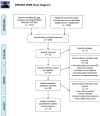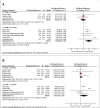Indicators of response to exercise training: a systematic review and meta-analysis
- PMID: 34301648
- PMCID: PMC8728353
- DOI: 10.1136/bmjopen-2020-044676
Indicators of response to exercise training: a systematic review and meta-analysis
Abstract
Background: Means-based analysis of maximal rate of oxygen consumption (VO2max) has traditionally been used as the exercise response indicator to assess the efficacy of endurance (END), high intensity interval (HIIT) and resistance exercise training (RET) for improving cardiorespiratory fitness and whole-body health. However, considerable heterogeneity exists in the interindividual variability response to the same or different training modalities.
Objectives: We performed a systematic review and meta-analysis to investigate exercise response rates in the context of VO2max: (1) in each training modality (END, HIIT and RET) versus controls, (2) in END versus either HIIT or RET and (3) exercise response rates as measured by VO2max versus other indicators of positive exercise response in each exercise modality.
Methods: Three databases (EMBASE, MEDLINE, CENTRAL) and additional sources were searched. Both individual response rate and population average data were incorporated through continuous data, respectively. Of 3268 identified manuscripts, a total of 29 studies were suitable for qualitative synthesis and a further 22 for quantitative. Stratification based on intervention duration (less than 12 weeks; more than or equal to 12 weeks) was undertaken.
Results: A total of 62 data points were procured. Both END and HIIT training exhibited differential improvements in VO2max based on intervention duration. VO2max did not adequately differentiate between END and HIIT, irrespective of intervention length. Although none of the other exercise response indicators achieved statistical significance, LT and HRrest demonstrated common trajectories in pooled and separate analyses between modalities. RET data were highly limited. Heterogeneity was ubiquitous across all analyses.
Conclusions: The potential for LT and HRrest as indicators of exercise response requires further elucidation, in addition to the exploration of interventional and intrinsic sources of heterogeneity.
Keywords: clinical physiology; health policy; sports medicine.
© Author(s) (or their employer(s)) 2021. Re-use permitted under CC BY-NC. No commercial re-use. See rights and permissions. Published by BMJ.
Conflict of interest statement
Competing interests: None declared.
Figures





References
-
- WHO . Physical activity. Available: https://www.who.int/dietphysicalactivity/pa/en/ [Accessed 13 May 2019].
Publication types
MeSH terms
Grants and funding
LinkOut - more resources
Full Text Sources
